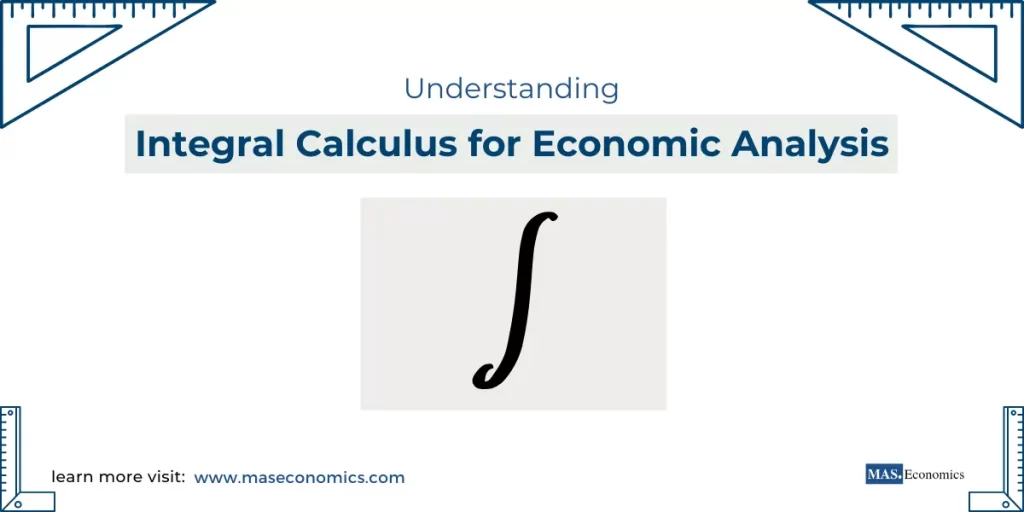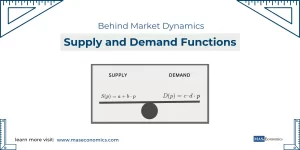Integral calculus is a powerful mathematical tool used extensively in economics to calculate aggregate quantities like total cost, revenue, and profit. While differential calculus helps in understanding the rate of change of a function, integral calculus goes in the reverse direction—it focuses on determining the original function from its rate of change. In other words, integration allows us to derive the cumulative effects of economic activity.
Understanding Integration
Differentiation and integration are inverse processes. While differentiation gives the rate of change of a function, integration helps us derive the original function from a given rate of change. This original function is called the antiderivative, and the return from the derivative to the antiderivative is known as integration.
In practical terms, if we know the marginal cost, which is the rate of change of the cost with respect to output, integration allows us to find the total cost function. This provides a broader understanding of costs, revenues, and profits in the economic context.
Consider the example of a company that has a marginal cost function given by:
\( C'(x) = 3x^2 – 4x + 21 \)
To determine the total cost function \( C(x) \), we need to integrate \( C'(x) \):
\( C(x) = \int C'(x) \, dx = \int (3x^2 – 4x + 21) \, dx = x^3 – 2x^2 + 21x + C_f \)
Here:
- \( C_f \) represents the fixed cost, which must be added to determine the complete total cost function.
Indefinite Integral
The indefinite integral represents the set of all possible antiderivatives of a given function. When we integrate a function without specific limits, we obtain an indefinite integral, which has the form:
\( \int f(x) \, dx = F(x) + C \)
Where:
- \( F(x) \) is the antiderivative of the given function.
- \( C \) represents the constant of integration because integration is not unique—different constants can lead to different functions that share the same derivative.
For instance, if we are given the function:
\( f(x) = x^2 \)
The indefinite integral is:
\( \int f(x) \, dx = \int x^2 \, dx = \frac{1}{3} x^3 + C \)
This constant \( C \) accounts for different vertical shifts of the function on the graph.
Definite Integral
The definite integral is used to calculate the actual numerical value of the integral within specified limits. It is particularly useful for determining total quantities, such as the area under a curve or the accumulated value of a variable over time.
The definite integral from \( a \) to \( b \) of a function \( f(x) \) is given by:
\( \int_{a}^{b} f(x) \, dx = F(b) – F(a) \)
Where \( F(x) \) is the antiderivative of \( f(x) \). The definite integral represents the area under the curve between the limits \( a \) and \( b \).
For example, if we want to determine the total cost over a certain level of production, we would integrate the marginal cost function over that range:
\( \int_{0}^{x} C'(q) \, dq = C(x) – C(0) \)
Practical Applications of Integral Calculus in Economics
Total Cost Function
In economics, understanding the relationship between marginal cost and total cost is crucial. The marginal cost function represents the cost of producing an additional unit, whereas the total cost function accounts for the entire cost of production up to that point.
For example, given a marginal cost function \( C'(x) = 0.03x^2 – 3x + 120 \), we can calculate the total cost function \( C(x) \):
\( C(x) = \int (0.03x^2 – 3x + 120) \, dx + C_f \)
Breaking down the components:
- Integrate each term individually.
- \( \int 0.03x^2 \, dx = 0.01x^3 \)
- \( \int -3x \, dx = -1.5x^2 \)
- \( \int 120 \, dx = 120x \)
Thus, the total cost function is:
\( C(x) = 0.01x^3 – 1.5x^2 + 120x + C_f \)
Where \( C_f \) represents fixed costs.
Revenue Function
Just as we can integrate the marginal cost to find the total cost, we can integrate the marginal revenue function to determine the total revenue. The marginal revenue function \(R'(x)\) represents the additional revenue obtained from selling one more unit.
For instance, if the marginal revenue function is given by:
\( R'(x) = 1044 – 0.6x \)
We can find the revenue function by integrating:
\( R(x) = \int (1044 – 0.6x) \, dx \)
Breaking it down:
- \( \int 1044 \, dx = 1044x \)
- \( \int -0.6x \, dx = -0.3x^2 \)
Thus:
\( R(x) = 1044x – 0.3x^2 + C \)
Where \( C \) is the constant of integration, which may represent some initial revenue condition.
Profit Function
The profit function is determined by taking the difference between total revenue and total cost:
\( P(x) = R(x) – C(x) \)
If we know both the marginal revenue and marginal cost functions, we can calculate the total profit by integrating and then subtracting:
\( P(x) = \int_{0}^{x} \left( R'(q) – C'(q) \right) \, dq – C_f \)
Graphically, the area between the marginal revenue and marginal cost curves represents the contribution margin for the quantity produced.
Finding Consumer Surplus and Producer Surplus
Integral calculus is also essential for calculating consumer surplus and producer surplus. These measures represent the benefit that consumers and producers derive from participating in the market.
Consumer Surplus is calculated by finding the area between the demand curve and the market price, up to the quantity exchanged.
Producer Surplus is calculated by finding the area between the market price and the supply curve.
Both of these can be found using definite integrals over the relevant price or quantity ranges.
Visualization of Integration in Economics
One way to understand the practical application of integrals in economics is through graphical representation. The area under a curve often has an economic interpretation:
For cost functions, the area under the marginal cost curve represents total variable costs.
For revenue functions, the area under the marginal revenue curve represents the total revenue obtained from sales.
Consider an example where the marginal cost function increases with production. Graphically, this would imply an upward-sloping curve. To determine the total variable cost for a certain level of production, we calculate the area under this curve from zero up to that quantity. This area represents the cumulative effect of increasing costs as production scales up.
Special Techniques of Integration
Integral calculus offers various techniques to handle more complex functions that may not be easy to integrate directly:
Partial Integration
Partial integration is used when the integrand is a product of two functions. This technique is similar to the product rule in differentiation, where we simplify the product into more manageable integrals.
For example, to integrate:
\( \int x \cdot e^x \, dx \)
We can use the partial integration formula:
\( \int u \, dv = uv – \int v \, du \)
Integration by Substitution
Integration by substitution is useful when the integrand includes a composite function. By substituting a part of the function with a simpler variable, we can transform the integral into an easier form.
For instance, consider:
\( \int x \sqrt{1 – x^2} \, dx \)
By substituting \( z = 1 – x^2 \), we can make the integration more straightforward.
Conclusion
Integral calculus is an indispensable tool in economics, providing a means to derive cumulative quantities from rates of change. Whether it’s calculating the total cost from a marginal cost function, determining total revenue, or understanding the interplay between revenue and cost to find profit, integration serves as the bridge between marginal and total analysis.
Through integral calculus, economists can effectively quantify and visualize economic activities over time, making it easier to understand and predict the behavior of complex systems.
FAQs:
What is the role of integral calculus in economics?
Integral calculus helps calculate total values such as total cost, revenue, and profit from their respective marginal functions. It allows economists to assess the cumulative effects of economic activities, providing insights into the overall performance and trends of different economic variables over time.
How does integration differ from differentiation in economics?
Differentiation focuses on calculating the rate of change (e.g., marginal cost or revenue), while integration works in the reverse—it finds the total or aggregate amount from the marginal values. In economics, integration is often used to determine total cost from marginal cost or total revenue from marginal revenue.
Why are definite integrals useful in economic calculations?
Definite integrals calculate the actual value of an integral over specific limits, such as a range of quantities or time period. This makes them ideal for computing total values like cumulative cost or revenue, allowing economists to assess quantities like consumer surplus or producer surplus within a specific market range.
How is marginal cost integrated to find total cost?
By integrating the marginal cost function, we determine the total cost function, which includes both variable and fixed costs. This total cost function provides a broader view of production costs across different output levels, helping firms understand the total expense of scaling production.
How is consumer surplus calculated using integrals?
Consumer surplus is found by integrating the area between the demand curve and the price level up to the quantity exchanged. This integration provides a measure of the extra benefit consumers receive by paying a price lower than their maximum willingness to pay.
What is the significance of the second derivative in economic analysis?
The second derivative helps assess concavity and determine points of inflection in economic functions. This is crucial for identifying areas of increasing or diminishing returns, understanding cost behavior, and assessing the stability of economic equilibria.
Thanks for reading! Share this with friends and spread the knowledge if you found it helpful.
Happy learning with MASEconomics




